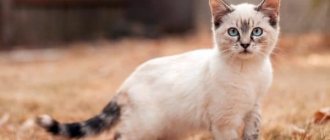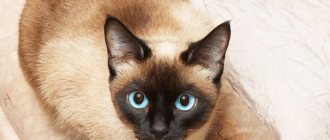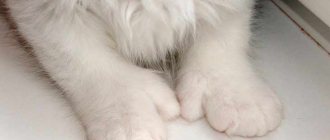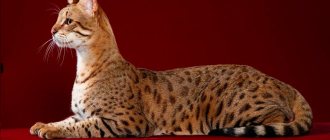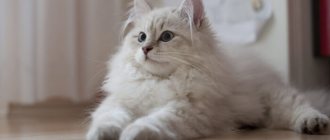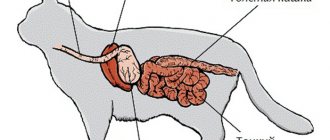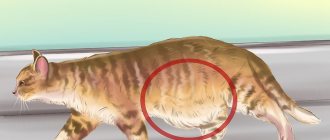Who can answer exactly how many cat breeds exist in the world?
You may be surprised by such a simple question, because everything seems not complicated at all - just look at the list of breeds in any reference book and the answer will be clear. But in practice, it turns out that even the most experienced cat lover is unlikely to be able to name the exact number of breeds. And what battles and disputes there were among breed breeders about the recognition of certain breeds - novels can be written about this.
But why is it so difficult to definitively decide on a list of cat breeds? After all, the first questions that many owners of our gorgeous pets have are similar:
- What breeds of cats are there?
- How are they formed?
- What breed is the most common (large, exotic)?
But it’s not just ordinary cat lovers who register breeds and describe existing ones, but special organizations. Otherwise, any person could breed the first animals they came across and say that they are the inventor of a new breed, demanding its registration. Of course, many people know that mixed breeds are now becoming fashionable in certain circles under the name “designer breed.” But in fact, of course, these cats are not any new breed.
Although the registration of new breed names and their inclusion in the official lists of breeds is actively carried out at the present time.
China: 53 million cats
China is considered one of the countries in which the attitude towards cats is quite ambiguous. The country has a huge market for pet products. There are a lot of homeless animals here and their number is constantly growing. Stray cats often carry various diseases and cause road accidents. The most common disease among four-legged animals here is atypical pneumonia, which causes cats to be abandoned to their fate. The most terrible and brutal thing is that in China they continue to kill pets en masse and eat them! Cat soup is considered a delicacy here (which is simply terrible!!!). I don’t know who calculated this and how, but according to statistics, almost 100 thousand poor animals are eaten by the Chinese population every day.
Now let’s decide who can even be called a purebred animal?
No matter how much we love all our Muroks and Barsiks, only those who have an identifying document - a pedigree can be called purebred. issued by a club uniting felinologists (specialists in keeping, breeding and selection of breeding animals). Each felinological organization includes several clubs. And a nursery that has pedigree individuals and is engaged in their breeding must join one or more such organizations.
As you can see, the organization of the system is quite serious, and it is necessary to understand the difference between clubs and associations of felinologists. The club (or a specific nursery) directly breeds purebred cats. He selects individuals based on appearance, color and pattern, and on characteristics of temperament and character. That is, it develops and maintains the breed standard. There are cases when a club develops new color variations or even a new breed, but it itself does not have the right to make a decision on approval. This is necessarily done by a larger organization, of which this club is a member.
Countries that don't love cats
But not all countries treat furry friends well and with respect. In some countries, four-legged pets are even eaten, for example:
Korea, Vietnam.
The culinary preferences of the residents can be explained simply - cats are useless animals for them, they do not want to spend money on their maintenance. Due to overpopulation in countries, there is a shortage of protein foods, so residents are calm about cat meat and eat it with pleasure.
Peru.
In this country, the tradition of eating cats arose during the colonial period. Enslaved residents were forced to eat whatever they could find. This tradition continues to this day. Peruvians organize a Festival once a year where any resident can eat cat meat.
Switzerland.
Incredibly, in some remote rural areas the cat is considered a delicacy. At Christmas, many residents bake it with wine and garlic sauce. And this is even considered a traditional dish on the New Year's table.
Australia, USA and New Zealand.
In these countries, cats are not eaten, but they are shot. Stray animals are caught and castrated and sterilized. In some states, captured pets are euthanized. There are shelters that look for new owners for animals, but not many people want to adopt an adult cat. In addition, owners must sterilize their pets, otherwise they will be given a large fine for violating the rules for keeping pets. The only exceptions are exhibition winners and animals used by breeders.
Indonesia.
Local residents are indifferent to four-legged friends. But recently the situation is changing. Thanks to the Association for the Protection of Pets, special classes have been introduced in educational institutions in which children and students are taught a love for their smaller brothers.
Now we come to the main point!
Only larger organizations that unite clubs can determine whether a new breed is officially recognized or not. This is how new cat breeds are created.
Associations determine whether the number of individuals of a new breed is sufficient to recognize the breed. Monitors compliance with the breed standard and the correctness of its description. And all questions regarding exhibitions (can it be held, when, where, start time, order of holding) are also in the hands of associations.
Now we have figured out how new breeds are officially recognized. It would seem that there should be nothing complicated further: we take all the known old ones, add registered new ones to them - and we have a complete list of breeds. But it was not there! The main difficulty is that there are a lot of organizations responsible for the standard. This includes about ten well-known international associations, such as WCF or CFA. And smaller regional ones.
Plus there are organizations built on outright deception: they do not care about quality issues, they are only interested in the money that can be collected from gullible newcomers! And for all these associations the number of breeds registered is different.
Therefore, it is impossible to say exactly how many cat breeds there are currently. About 70 are registered with WCF.
It must be remembered that breeding new breeds is painstaking work carried out by professional breeders. Do not fall for the tricks of scammers: if you want to purchase a purebred animal, carefully check the clubs, documents, and study the breed standard.
There are countries where cats are more popular, and others where dogs are more popular. Russia belongs to the first group, because according to Dalia Research, 59% of families keep cats at home. But the World Atlas Geographical Service once decided to calculate how many cats there are in the world, and it succeeded.
In total, according to statistical data, about 600 million cats live on our planet, but only 200 million of them are domestic cats. Some people get pets for religious reasons, some use them to fight rodents, and some he just can’t get past the fluffy little ball and takes it home. In 2020, a list of the 10 most “catty” countries was compiled.
USA
According to the World Atlas, about 76.5 million cats live here. Every third family has furry pets, and many do not limit themselves to just one animal. Having 2-3 cats in the house is considered the norm for Americans. They do not chase the breed and often take pets from animal shelters or from the street. In this country, it is customary to give kittens as gifts for the holidays, and according to statistics, only 3% of them are elite breeds.
China
Despite the terrible tradition of killing and eating cats (their meat is considered a delicacy in the southern provinces), China ranks second in popularity of these animals. There are about 53 million cats in the country. Residents easily take them from the street, from shelters, and at the same time just as easily part with them if they are tired of the pet. The number of homeless people grows exponentially every year, which is why in recent years organizations have been registered in China to protect animals from the tyranny of people. Even at the state level, humanitarian programs have already been developed to combat vagrants.
Russia
Local experts tried to calculate how many cats live in Russia, and their data turned out to be much more interesting than the world’s: 30 versus 12.5 million. In Russia, cats are ahead of even dogs: 37 versus 30%. Every third family gets a pet: 2/3 of them take a kitten from the street, and 1/3 from nurseries. Every year, cat shelters are opened in cities and towns: this is how the state and volunteers fight the growing number of homeless people. Our breeders even developed a new breed - Russian Blue.
Brazil
Shared 4th place with the Russian Federation, 12.5 million cats were counted here. The data is approximate and is based on an analysis of sales of pet food and pet accessories. Over the past 10 years, there has been a real boom in cats in Brazil, with sales of cat products increasing by 37% every year. If we compare the same data with Russia, then we can say with confidence that in our country there are more pets than street cats.
France
In Old Europe, cats were valued not as pets, but as a fashion accessory. Even a black cat was chosen as the symbol of this country. Perhaps France is the only state where it is possible to accurately count the number of pets, because each animal must be registered in the national database. He is given a microchip or a stamp indicating information about the owner. According to the World Atlas, the French raise 9.5 million cats.
Italy
This country does not lag behind France, but people’s attitudes towards cats are radically different. Love rules here: there is no registration, every family has at least two cats, and people take patronage over stray animals. Complete freedom - this is the principle by which animals live in Italy. They are not kept in shelters, but simply fed and released into the wild; the cats are not denied access to shops and cafes.
Great Britain
The number of cats in Britain is 7.75 million animals. This country has a law on the protection of pets, and the increase in homelessness is carefully monitored, because almost 85% of kittens in England are born “outside the plan.” State shelters are being opened and volunteer programs are being financially supported. To reduce the number of stray cats, sterilization measures are being implemented.
Germany
The Germans adore cats no less than the British; in this country, the Geographical Society also counted 7.7 million cats. Here the animals are surrounded with special love: they are bought expensive food, expensive accessories, and walked on a leash, like dogs. At the same time, the problem of homeless animals remains: the authorities were forced to introduce a ban on the free walking of uncastrated cats in order to prevent their uncontrolled reproduction.
Ukraine
There are 7.5 million cats in this country, half of them are domestic, elite or simple mousecatchers, the rest are strays. Protection of the rights of the latter is absolutely not ensured at the state level, there is no punishment for throwing pets onto the street, the opening of shelters remains only the work of volunteers.
Japan
It is very strange that the Land of the Rising Sun was in 10th place in the World Atlas ranking, because there is a cat temple and even cat islands. Cafes and salons for furry pets are opening. The cat population is 7.2 million.
The ancestor of all cats in the world was a steppe species (according to another version - a forest one), which began to be domesticated 12,000 years ago. It was from then on that selection arose, during which an animal acquired certain traits beneficial to humans and lost others. Now it is difficult to answer how many breeds of cats exist in the world, but it is possible to understand this issue.
The uncertainty in the number of breeds occurs due to the fact that there are simultaneously 3 largest felinological organizations in the world:
- WCF is the World Federation, the largest and most authoritative at the moment. It was founded in 1988 in Rio de Janeiro and has more than 540 clubs.
- FIFe is one of the participants of the World Felinological Congress. Created in 1950 in Belgium.
- TICA is an International Association, founded in 1979 in the USA, but later acquired an international format.
The main difficulty is that these organizations do not register and recognize breeds at the same time. Most often this happens over time, but sometimes a species recognized by one organization is never confirmed by others. In addition, several breeds are constantly at the stage of preparation and documentation.
Each organization applies its own criteria and parameters to determine purebredness. Most often these criteria are:
- body shape and body proportions;
- eye color;
- temperament and character;
- characteristics of wool;
- health characteristics, etc.
Currently the most varieties are registered in the WCF: about 74, 9 of which are recently registered. FIFe and TICA declare 51 and 73 varieties respectively.
Wild cats
It is also impossible to determine how many cats are in the wild on planet Earth. Their representatives live on all continents except Antarctica. Some species have fully adapted to being close to humans. Thus, the lynx totals about a million individuals in the world. But some cat populations are dying out before our eyes, despite constant offspring, and therefore it is difficult to say exactly how many cats there are on earth. This is due to human activity and environmental degradation.
© shutterstock
There is such data on endangered species.
- lion - currently lives less than 20 thousand;
- cheetah - less than 15 thousand;
- tiger - no more than 6 thousand;
- Asian leopard - approximately 100 individuals;
- snow leopard - a snow leopard with the most beautiful fur in the world - less than 100 individuals;
- white lion - several dozen.
Classifications
The main classifications of cat species are divided according to 4 main criteria:
- by physique;
- by coat;
- by color;
- according to the drawing.
By physique
According to this parameter, cats are divided into 6 main groups:
- Animals with a powerful physique (heavy type). These include the largest representatives. They have the thickest and strongest tail, powerful stable paws and a large short neck. Typical representatives are Maine Coons or Siberian cats.
- Kobby (stocky). They have a dense and stocky build. The skeleton is characterized by a wide chest, a large head with a short and wide nose is placed on a shortened neck, which sometimes seems almost absent. Usually the paws are not very high, and the tail is short with a blunt end. An example would be exotics or Manx.
- Oriental. They have a graceful structure with high paws. There is a graceful neck and a narrow long tail. The head and muzzle are always tapered towards the nose. Typical Orientals are Javanese and Balinese cats, as well as Siamese cats.
- Foreign. Flexible body with pronounced muscles. High paws and long tail, wedge-shaped head, oval or almond-shaped eyes. Ears may be elongated. The Abyssinians serve as an example.
- Semi-foreign. Those with average parameters are more common than others. Representatives are American Shorthairs or Russian Blues.
- Half-cobby. Slightly stockier breeds than the previous type. A typical representative is the British Shorthair.
By coat
According to this parameter, cat breeds are divided into 5 varieties:
- long-haired with hair up to 15 cm long (Burmese, Siberian, Persian cats);
- shorthair (Egyptian Mau, Chartreuse, Russian Blue);
- curly coat (German Rex, Cornish Rex);
- Wirehaired (American Wirehair);
- without wool (, bambino, sphinx).
By color
There are a huge number of colors, but they are all divided into the following main types:
- single-color (korat, havana);
- two-color (Norwegian forest, ragdoll);
- motley (color-point, angora);
- with specks (Persian chinchilla or American shorthair cat);
- multi-colored or tortoiseshell (bobtail, sphinx, Persian).
According to the drawing
The main variants of patterns that form the breed:
- solid pattern (red, black, brown, gray, etc. breeds);
- zonal color (striped, marbled or spotted tabby);
- white spotting (mostly a whole color with spots of different colors);
- solid white;
- color-point (light body and dark limbs);
- silver (smoky, silver, chinchilla and cameo).
Some of the drawings can be viewed in the gallery:
Description of the main breeds
The main types of cats were derived from the earliest, but not always the most widespread, breeds. And now breeders continue to experiment with these species, achieving new results.
- British.
They became the founders of two main lines: British Longhair and Shorthair, the older of which is the Shorthair. Both species are characterized by ideal hair, which is very easy to care for: it does not mat and does not shed as actively as other representatives of the cat world. - .
Their color resembles wild rabbits, which is why they got their first name - “rabbit cats”. Very easy-going, with a good disposition and graceful body. - Scottish.
There are 2 main forms - straight-eared and lop-eared. The basic one was straight-eared, and lop-eared was the result of genetic experiments, during which it was possible to fix the gene responsible for the regression of cartilage tissue. - American Curl.
The main distinguishing feature is the ears, which bend inward or backward at different angles. The inner surface of the auricle is densely pubescent. American Curls are very active animals; their playfulness and activity remain in them until old age. - European Shorthair.
Experts believe that this breed was formed with minimal human intervention. It is quite difficult for a non-professional to distinguish these cats from ordinary yard cats, since they are as close as possible in genotype and appearance. - Angora.
There is an opinion that she became the predecessor for all long-haired pedigree groups. A distinctive feature is the absence of undercoat and a thick collar around the neck. - Egyptian Mau.
Of all the species currently known, the Mau is the most ancient. Her image was first drawn 3 thousand years ago. Her eyes look very unusual: they seem to be lined with eyeliner, and a “W” pattern is visible between her ears.
The history of cats is still shrouded in mystery. Today it is known that ancient people depicted these animals in manuscripts and drawings 10-15 thousand years ago.
Each breed, each type of cat has its own unique history, which dates back to ancient times. A lot is known about cats, but not everyone knows where cats came from, why they began to live side by side with humans, where their history began in Russia and how they spread throughout the world.
- Show all
Origin of cats
A cat is a genus of mammals from the cat family, the order is carnivores. There are currently about 600 million pets around the globe.
Cats descended from forest and steppe ancestors who were wild for a long time.
The word cat comes from the Old Russian word “kotka”, which in turn comes from the Latin - “cattus”.
Scientists are still arguing about the origin of these animals on Earth. At the moment, there are two known theories - one biblical, and the other scientific.
The first theory-legend tells that during the Great Flood, rodents appeared on Noah’s ark, which posed a danger to the animals from the ark. Then the lion clan gave birth to cats, who dealt with all the rodents and saved the living creatures from them.
The second theory says that the first cats on the planet appeared long before their domesticated relatives, namely about 60 thousand years ago. The prehistoric predecessor of cats is considered to be the ancient inhabitant of Madagascar - the Fossa.
Many zoologists believe that the ancestor of cats was Proaiurus, a currently extinct species.
It gave rise to two branches:
- Ancient saber-toothed cats (extinct).
- Representatives of modern felines.
If we look at historical reports and genetic analyses, the first domestic cats were discovered in ancient villages about 10 thousand years ago.
Domestic cats spread across the globe in two waves. The first wave occurred at the height of agriculture, about 9-12 thousand years ago. And the second wave began in Egypt and gradually spread to all of North Africa and Europe several thousand years later.
Worship of cats in Ancient Egypt - interesting facts
Cats and Egypt
Many scientists believe that it was in Egypt that the domestication of animals began.
Three species are known to live in Ancient Egypt:
The domestication of animals began with the fact that in Egypt, grain collected from the fields was eaten by rodents. When people noticed that cats were hunting them, they began to attract them. This is how pets began to exist side by side with humans.
It was for these merits that cats were dubbed sacred animals that protected supplies and saved people from hunger. If we turn to Egyptian ancient sources, we can see that God Ra was depicted with a cat's head, and the Goddess of Fertility was depicted as a cat.
To better understand how people treated these animals, here are some interesting facts:
- 1. People even built temples for cats, where the dead were mummified. The death of an animal was perceived as the death of a relative, and in honor of him, family members shaved off their eyebrows.
- 2. Cats were considered the property of the state and it was strictly forbidden to export them.
- 3. A cab driver who accidentally ran over an animal was stoned to death.
- 4. In the battle against King Cambyses, the opponents tied cats to their shields, the Egyptians did not attack and lost the war.
- 5. If a disaster came to the city (for example, a fire), then these animals were rescued first, the children were next in line.
- 6. Rulers and clergy listened to the emotions of cats, as it was believed that they could speak with the gods.
But there are also places where cats are deprived of due attention.
France
. Refined French people prefer not to stand on ceremony with cats. If a kitten is not bought in a French pet store for a month, then it is euthanized, believing that it will certainly not be bought in the future. France is not the only state to practice such brutal methods; In this way, politicians are allegedly trying to control the number of these animals, because stray cats are carriers of diseases. But the French do not give offense to their pets.
Cats are not very popular in Ireland
. There dogs are completely adored, and cats are not even considered pets. Discrimination is also facilitated by local television, where there is practically no place for cats, but people with dogs are regularly shown. However, many elderly women in Ireland are happy to keep tailed outcasts.
Indonesia
. Cats are of little concern to local residents. They have to lead a wild lifestyle, easily finding food except on the altars near the temples - offerings from the devout Balinese. Although cats are not offended - after all, for the locals this is considered a bad omen.
Australia
. In the homeland of kangaroos, there are even more stray cats than in Indonesia. Because of this abundance, Australia's largest city even imposed a curfew for cats. After all, one day they gathered in groups and began to hunt possums. Australian cats have gone completely wild!
Things are much worse for cats in distant Vietnam
. Although there are a lot of living creatures on the Vietnamese streets, mustachioed robbers cannot be found during the day with fire - both street and domestic. Perhaps the monks can shelter several cats in their temple, or a rare pet store will find such an unpopular specimen here. But the whole point is that the Vietnamese are extremely superstitious people. The cat “meow” and “nyau”, which are so touching for us, mean “poverty” in Vietnamese. To avoid incurring this misfortune, the Vietnamese diligently avoid all contact with cats. And all the charms and advantages of these animals are not of the slightest interest to the superstitious Vietnamese.
In distant Cuba
There are practically no cats left - during the 90s, when famine reigned in the country, almost the entire population was eaten. Although the Cubans did not touch dogs in those days.
In Gabon
And
Guyana
doesn't keep cats at all.
in Peru
either, but there is one delicate nuance - this situation has developed there, perhaps, due to the fact that the Peruvians, excuse me, eat cats for lunch, following an ancient tradition. But that's a completely different story.
As we can see, each country has its own special attitude towards cats. We are sure that if your cat wants to travel, this little guide will be extremely useful!
Animals in Russia
It is still unknown exactly where cats came from in Russia, but it is known that in the 12th century animals already lived in Rus'. They were in small quantities and were worth their weight in silver, like oxen and other arable animals. Therefore, not many could afford them.
For murder, as in ancient Egypt, punishment was imposed - but more lenient - a huge fine, because it was these animals that saved the crop from rodents.
By the 15th to 18th centuries, cats became more common and could be afforded by ordinary people. But closer to the 19th century, there were so many of them in the villages that the peasants handed them over to special people for their skins. Then the clergy, concerned about the cruel behavior of people, again issued a decree to protect these animals. Special openings were even made in the temple gates to make it easier for pets to enter.
Over time, cats spread widely throughout Rus'. They were considered an attribute of wealth and prosperity. A decree was issued stating that every store must have a cat that ate mice, thereby protecting people from dangerous infections and epidemics.
Pets were ordered by rich people from Holland and other countries. The animals lived at the court of Catherine the Great, daughter of Peter the Great and Nicholas the First.
From those times came proverbs and sayings related to pets. In mythology, it was believed that cats help the brownie in his work. Black cats are known to be especially shrouded in myths and legends. It was believed that through black animals the brownie learned about the affairs of the family who lived in the house. They were believed to be the best mouse hunters.
A ritual that has survived to this day is that the cat should be the first to enter a new house. Then in such a house there will always be order, prosperity, comfort and a lot of positive energy.
There are holidays dedicated to pets. In Russia it is March 1st, and in the world it is August 8th - World Cat Day.
According to statistics, at the moment there is one pet per 4 families.
Among them there are all kinds - simple, outbred or rare and purebred. A little history about the most common breeds.
The most cat-friendly countries
First of all, it is worth mentioning about Japan
. Here cats are respected, one might say that a cult of neko has developed - that’s how it would be “cat” in Japanese.
The fashion for cat cafes came from Japan. Now there are more than a hundred of them in the Land of the Rising Sun! Murka lovers pay good money for the opportunity to drink a cup of coffee and play with their furry pets, feed and pet them.
Many modern Japanese houses and apartments are planned with the cats of their future owners in mind. The living space is equipped with cat towers, tables with many holes, rooms decorated with materials that are resistant to cat claws - everything to make the cats feel at home in every sense.
There is even a Cat Temple in Kagoshima, which is dedicated to seven cats who lived in the 17th century. A certain military leader took these cats to war - they served for hours; the soldiers determined the time by the narrowing or dilating pupils of the brave cats.
A symbol of good luck in Japanese folklore, the cat has become firmly entrenched in local culture. Cat souvenirs are sold everywhere, street fashion is full of cat elements - cat ears are especially popular, and rare anime is complete without whiskers - tabby ones.
Crazy about cats in Israel
. Guests of this country immediately notice the abundance of cats on every street, every step. Cats seem to be part of the urban landscape. The Israelis are known for their cat-friendly laws: for example, in 2011, declawing cats was legally prohibited. Many residents regularly feed stray cats.
Italy
- another paradise for cat lovers. Visitors to Rome are delighted to see colonies of cats roaming around ruins and ancient monuments.
Rome is famous for its cat shelters. One of the most famous is located in Torre Argentina. These ancient ruins became home to a cat army numbering more than two hundred individuals! Guests of the shelter enjoy feeding the cats, which are regularly monitored by a small team of volunteers, caring for homeless animals. There was recently an attempt to shut down this cat sanctuary, but thousands of people signed a petition in its defense. As a result, the shelter was preserved, and, moreover, the Superintendent of Rome for Culture declared the cats part of the Roman cultural heritage.
Türkiye
- a country of cat lovers, where cats roam freely everywhere; and the Turks treat them with extreme respect. However, this is common to all Muslims. Cats in Turkey, like in Japan, are also considered part of the culture. Istanbul is especially famous with its impressive number of stray cats.
Greece
. Even stray cats in Greece are always happy and well-fed. Rarely a Greek keeps a cat at home, however, on the street he will not fail to treat the furry creature with a fish or something else. Happy Greek cats walk wherever they want, and if they get hungry, compassionate residents will be happy to feed them.
Belgium
. Lately there have been more and more cats here. Microchips have even begun to be introduced into domestic cats so that owners treat their pets more responsibly. And residents of the small town of Ypres regularly hold a Cat Festival. This is a real carnival, where you can see huge dolls of cats and cats, themed competitions, shows and dances.
England
. Lovers of home comfort, the British were among the first to organize a cat exhibition and open a Cat Lovers Club. The British keep cats at home more than dogs. They walk their furry ones like dogs on a leash so that they don’t run away.
Croatia
. Cats are loved here and called “machka” - this is how “cat” sounds in Croatian. And they call them with the exclamations “mats-mats”, and not “kiss-kiss”, like we do.
Montenegro
. In this Balkan country, cats are respected, just as in Croatia they are called the characteristic “matz-matz”, and are happily kept at home.
Thailand
. Cats are not kept in houses here, except in yards. But in Thailand it is warm all year round, so there are plenty of fluffy streets. They are fed regularly and the cats live just fine in Thailand.
Egypt
. In ancient times, as we have already said, cats in Egypt were revered as sacred animals. Respect went so far that after the death of a pet, the owners shaved off their eyebrows as a sign of grief. A lot has changed since then, but there are still a lot of cats here, and they are very loved.
Germany
. And the Germans distinguished themselves by creating the first cat museum. The exhibits were collected by Angelina Ramsperger all over the world, and at the moment there are more than three thousand of them in the museum.
USA
, Little Rock. Cat races are held here every year. Cats are allowed to race over a distance of 150 meters, and the winner receives the main prize of 2 thousand dollars.
In Russia
love cats, many even keep more than one pet at home. In our homeland there is a unique and already legendary cat theater under the direction of Yuri Kuklachev. Cat performances regularly attract full houses of touched spectators.
Frajost
. This tiny coral island in the Indian Ocean is notable for the fact that it is inhabited exclusively by cats. In 1890, a ship crashed on coral reefs; the crew was unable to escape, but the cats that were there survived and have since multiplied, populating Frajost. Now more than a thousand cats live there.
China
. The Chinese used to love cats, but with a strange love - they loved to eat them. Now it is believed that they no longer eat. Many Chinese have a cat as a pet, and there are also many of them running around and strays on the street.
Fold cats
The first mentions of this breed date back to the 19th century, but other than the fact that a cat similar to a fold-eared one was described in the literature, no more information is provided.
Folds are a Scottish breed by origin. But much of the credit for breeding and improving the breed belongs to the British. They kept records of all individuals and even wrote down the names of the owners and names of the animals.
There, through genetic research, interesting facts about the lop-eared gene were revealed. He is not as harmless as he seems. It involves deformation of cartilage, which leads to disruption of the bone skeleton and health problems.
In Scotland, the first mention of fold-eared cats dates back to 1959. According to historical reports, farmer William Ross really liked his neighbor's cat, whose ears were unusually folded. This was Susie, who was born from the simplest parents and was unlike the rest of her relatives.
In 1961, Susie gave birth to two kittens, who also looked like their mother. This is considered the beginning of breeding Scottish Fold cats.
All fold-eared cats on the planet are brothers and sisters from the same mother - Susie. For this reason, the breed was at risk of mutations. Then the Ross family turned to geneticists who developed a crossbreeding program. They began to actively breed fold-eared animals, opened a nursery, and soon the association of cat lovers recognized fold-eared cats as a breed.
Fredjos
The unique island in the Indian Ocean is a real cat state. The only owners of this territory are cats. It's all because of a shipwreck that occurred in 1980 off the coast of Fredjos. Several people still survived and made it to land, taking with them a few cats. Only if people were unable to take root in this area, the cats gradually adapted to the new conditions, learned to get their own food and began to reproduce. Feeding primarily on sea creatures, the island's cat population numbers over a thousand individuals.
Siamese cats
Thailand is considered the birthplace of the well-known breed of pets, and its age is over 600 years.
There are suggestions that Siamese cats originated from a branch of wild Bengals.
This fact has not been reliably confirmed, but scientists are based on the unique gestation period for kittens - 65 days.
This variety was described back in the 14th century. Ancient messages say that Siamese cats were messengers to the other world and were highly valued by clergy. At the end of the burial sacraments, the cats were presented with gifts - these were delicacies and silk pillows.
Siamese representatives were brought to Europe only in the 19th century as a gift to the English ambassador from the hands of the ruler of Thailand. It was then that the spread of such graceful and beautiful pets began.
British cats
British cats are the heritage of Great Britain. The breed is widely known - large animals with short but very thick hair.
But there is an opinion that the Romans brought the British, because a large number of engravings and paintings were found depicting animals very similar to modern representatives of the breed.
Very little information has been preserved about the origin and breeding of cats. At that time, no one kept records and the breed developed on its own.
Only in the early 20-30s did professional breeding of the British begin.
Canadian Sphynxes
Canadian Sphynx
The history of the appearance of sphinxes goes back to ancient times, because it is believed that the Aztecs were the owners of “hairless” cats. Their origin on Earth still remains a mystery.
The Canadian Sphynx arose in 1966, when an ordinary cat gave birth to a completely hairless cub. When he grew up, he was bred with his mother, resulting in both normal and hairless kittens. Then they started crossing hairless kittens, and they created a new breed. The result was two types of animals that were slightly different in appearance. The vitality of the Canadians was low, as gene mutations occurred, and this breed would have died out if not for chance.
One day in a Minnesota cattery, to the great surprise of the owners, a hairless cat was born, and then a year later a hairless cat. After crossing them, viable and healthy offspring were obtained. This gave rise to the breeding of the breed.
The question of the number of cat breeds still remains unresolved, since the system of characteristics of varieties in different associations is not the same. There are 4 main felinological organizations in the world, as well as 8 large and several small ones. Only these associations have the right to register a new breed. There are different methods for identifying new cat varieties within each organization, which is why the number of "legalized" breeds fluctuates.
USA
In the late 80s, a rumor spread in California that cats were carriers of AIDS. This led to mass killings of pets. Scientists had to spend a decent amount of time trying to prove the truth to the Americans. And today, the number of cats in the United States cannot be counted, but the amount they spend to feed them is incalculable. Statistics allocate 4 billion dollars a year to the food of baleen-stripes. This is the biggest waste of its kind in the world. The magnitude of the amount is more striking when you consider the fact that infants contribute only $3 billion to the budget during the year.
Felinological organizations
On the website of each association you can see what standards exist and what should be a prerequisite for a particular breed. This information is published so that animal owners do not fall for the tricks of unscrupulous people who pass off a mixture of a Persian cat and an Abyssinian cat as “unique.” Nowadays this phenomenon is in fashion, and some breeds bred in this way are called “designer”. But they can ask for a large amount of money.
In
any case, when purchasing, you must always ask for a pedigree; without it, the cat cannot be considered purebred.
This document is compiled and issued by felinological clubs, and the organization is an association of such clubs.
Organizations existing today:
- WCF is the most famous, allowing 70 varieties of cats, 9 new ones (which includes Savannah, Tiffany, Bristol, York Chocolate and others), “no species” (domestic), and not yet recognized unregistered ones;
- FIFe has 51 cat breeds;
- TICA speaks of 73, “mongrel”, 3 practically recognized (Serengeti, Highlander DS (longhair) and Highlander KSH (shorthair), one provisionally recognized (Minskin);
- The CFA has "legalized" just over 40 varieties of pets;
- Others: GCCF, International Feline Association (IFA), ICU, Assolux, WACC, ASC, AFC and FARUS.
Types of cats
To find out how many cat breeds currently exist in the world, you need to look at the list of varieties that are recognized by the three largest felinological organizations (WCF, FIFe and TICA):
- 1. Maine Coon.
- 2. Egyptian Mau.
- 3. Abyssinian.
- 4. Peterbald.
- 5. Balinese (Balinese, Bally).
- 6. Siamese.
- 7. Burma (Burmanskaya).
- 8. Cymric.
- 9. Persian (Kolopoint). TICA distinguishes 2 types: Persian and colorpoint, while others consider this to be one cat breed.
- 10. Sacred Burmese.
- 11. Oriental DS.
- 12. Oriental CABG.
- 13. Exotic.
- 14. Norwegian forest.
- 15. Korat.
- 16. American Curl DS.
- 17. American Curl KSh.
- 18. Siberian.
- 19. Kurilian bobtail DS.
- 20. Kurilian bobtail KSh.
- 21. British KS.
- 22. Don Sphynx.
- 23. Devon Rex.
- 24. Manx (Manx cat).
- 25. Cornish Rex.
- 26. Ocicat.
- 27. Russian blue.
- 28. Japanese bobtail DS.
- 29. Japanese bobtail KSh.
- 30. Ragdoll.
- 31. Somalia.
- 32. Bengal.
- 33. Turkish Angora.
- 34. Turkish van.
- 35. Neva Masquerade.
- 36. Canadian Sphynx.
- 37. Chartreuse.
To obtain registration of a cat variety, it is necessary to prove the “right to exist.”
Therefore, recognition takes time.
Organizations may disagree. This leads to the fact that some cat breeds are recognized only by separate groups, and the total number fluctuates:
- WCF considers such varieties as Australian Mist, Tabby (Asian), Anatolian, Arabian Mau, Brazilian KSh, York, Canaani, Karelian Bobtail KSh and DSh, Mekong Bobtail, Ragamuffin, Scottie Straight, Chantilly Tiffany, Ural Rex DSh and KSh. These species are not registered in TICA and FIFe.
- TICA recognizes the following: Minskin, Ojos Azules and Ojos Azules DS, American Bobtail DS and CS, Havana, Pixie Bob CS and DS, Savannah, Serengeti, Toyger and Javanese. WCF and FIFe do not consider these breeds.
- FIFe recognizes Seychelles DS and KS, which others do not allow for registration.
